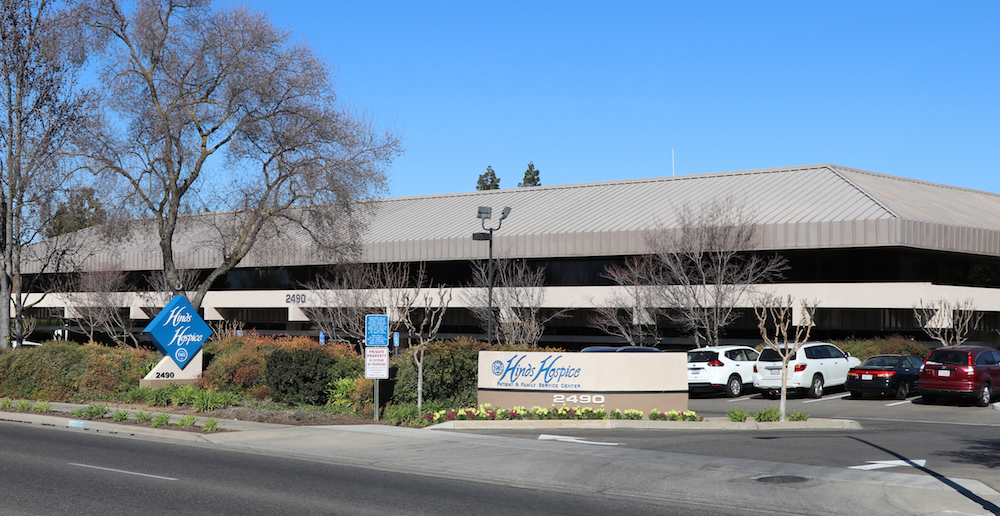
Hinds Hospice Patient and Family Service Center in Fresno.
Written by Ben Hensley
When it comes to the health care system, many people think of hospital workers, doctors, surgeons and nurses. End-of-life hospice care, however, is one branch of the system that has been forced to adapt just as much as many other medical facilities, if not more.
The transition from in-person end-of-life care to pandemic era end-of-life care has posed a new set of challenges for hospice centers as well as clients.
Mary Wienholz, whose mother was placed in hospice care shortly after the onset of the Covid-19 pandemic, said her firsthand experience was both good and bad.
“She was hospitalized after the pandemic started,” Wienholz said. “Not being able to go into the hospital with her — we chose to keep her here at home.”
Wienholz, who had to convince hospital staff to see her face-to-face after receiving limited virtually accessible assistance, said the hospital was planning to release her mother with medical equipment, but the challenges of the pandemic didn’t enable them to give her proper instruction on how to use the equipment.
“Everybody was ‘passing the buck,’” Wienholz said. “The truth is, when my mom first came on home health care and hospice, because of the pandemic, they had less home visitation for people to come and show me what to do, and I was struggling.”
Hospice centers, however, were also struggling to adapt to the ever-evolving pandemic.
Ann Guerrero, chief clinical officer at Hinds Hospice, said that various methods were tried at the beginning of the pandemic.
“Before the pandemic, the hospice industry did not have the ability from a legal perspective or from the CMS (Centers for Medicare and Medicaid Services) or Medicare perspective to complete hospice visits via telehealth,” Guerrero said.
Guerrero said the delay on telehealth procedures made it very difficult to see patients early on.
Eventually, when things settled down, centers were able to once again see patients, albeit in a more strained capacity.
Unfortunately for Wienholz, the hospice center she sought out did not develop techniques as quickly as Hinds Hospice did.
Wienholz, said her experience with her mother at a different hospice center was dramatically different, with the initial in-home visiting nurse conducting herself in a very unprofessional manner.
“The first nurse that I was assigned from hospice didn’t give me proper instructions that you’re supposed to get at the very beginning,” Wienholz said.
“She mentioned nothing about products or ordering supplies,” Wienholz said, among other communication issues with the nurse, including several times when the nurse didn’t even show up at the house.
She had been referred to this nurse by the hospice center, and was assured that she was very professional and work-oriented; Wienholz however recalls that the nurse not only neglected phone calls from Wienholz herself, but also that her social workers could not get a hold of her either.
“I just felt like my mom was a burden to them,” Wienholz said.
According to Wienholz, the original nurse was no longer working for the center by the end of the ordeal.
Eventually, however, she was able to find a replacement nurse who was shocked to learn the original nurse neglected to provide Wienholz with instructions on how to take care of her mom.
The second nurse, Wienholz said, was much more professional, assisting her mother when she visited,
“I felt the most pressure lifted off of me by them coming and caring for her that way,” Wienholz said. “The health aids were probably the best thing about hospice.”
Guerrero explained that following approval of telehealth visits, Hinds started them right away.
And though their meetings were still conducted virtually, Hinds did begin seeing patients both in-home and via telehealth.
When it came to protection, Guerrero said Hinds still practices the steps to this day.
“We still kept those in place. We’re following the guidelines of the CDC and CDPH (California Department of Public Health) and the health departments in the three counties that we serve,” Guerrero said, adding that Covid screenings are still conducted twice daily, and group meetings are still limited in size.
“We are also still testing our team members twice a week routinely for Covid,” Guerrero said.
Despite struggles initially during the pandemic, hospice centers have a better grasp on things now than they once did.
Guerrero commends the hospice workers who “are doing care out in the community and going into patients homes and potentially being exposed to things that we don’t have control over.” She was grateful and humbled at how her team has taken initiative to meet the challenges the pandemic has brought.
Wienholz, despite not having a smooth introduction to hospice care, understands that while the pandemic made things difficult for hospice centers, people in general need to be prepared for what to expect.
“I don’t think the general public is educated enough on what to expect when your parents or relatives get older,” she said.
“They just need to know that there are resources out there to help them.”








